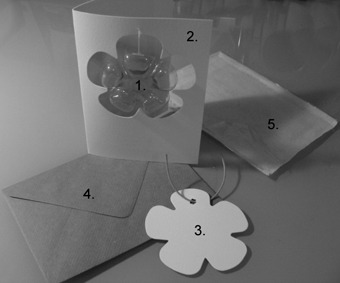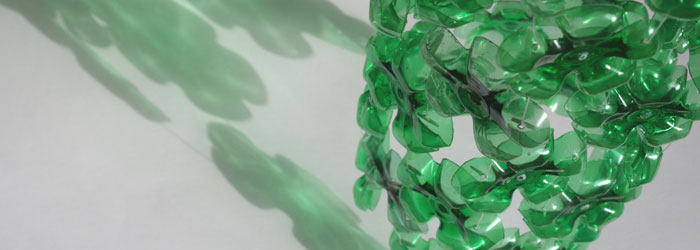All my work carries a design narrative of how it came to be. Eco cards which are cards in the physical sense but actually mini works of ecological art, which represent sustainable closed looped processes.
I am going to explain what I mean by this…..

1.
Plastic Bottle Base
Each bottle base is cut out individually by hand and can be used as a decoration. The bottles used have been rescued from St Mary’s Hospital in Manchester. The rest of the bottle is recycled at Emerge Recycling in East Manchester.
2.
Card
The card is made from recycled materials. It would have been cheaper to use virgin paper (paper containing no recycled fiber) but this card was made by Monadnock, a mill certified by the Forest Stewardship Council, an international, non-governmental organisation dedicated to promoting responsible management of the world’s forests. The card has been cut and dye cut locally in Manchester. It is an ‘A’ size, the most waste and cost-effective format to use because all materials and printing presses are based around it.
3.
Label for present or package
The gift tag is the negative or cut piece from the centre of the card, thus waste has been designed out.
4.
Envelope
Many envelopes cannot be recycled because glue usually contains latex and is therefore toxic. Thus, it is really bad news for recycling. However, my envelopes have a latex-free water- based adhesive and can therefore be completely recycled.
5.
Protective layer
Finally you think you have designed a significant eco card and successfully conquered all its challenges but then there is one aspect you do not have any control over: all the shops you sell in want you to protect your work in a plastic envelope! My protective layer for the time being, is what they use to sell pre weight sweeties!
Ink and text
The text on the inside “it takes about 450 years for just one plastic bottle to break down in the ground” has been hand printed in Manchester. I have insisted that only environmentally friendly biodegradable vegetable or soy oil is used on my eco cards. This replaces mineral oil and petroleum as the base for much printing ink. Vegetable-oil based inks can be made from a variety of vegetable oils including soy-bean, corn, and linseed oils. Replacing mineral oil with vegetable oil means that you can reduce or even cut out Volatile Organic Compound emissions, linked to breathing difficulties, liver and kidney damage.
